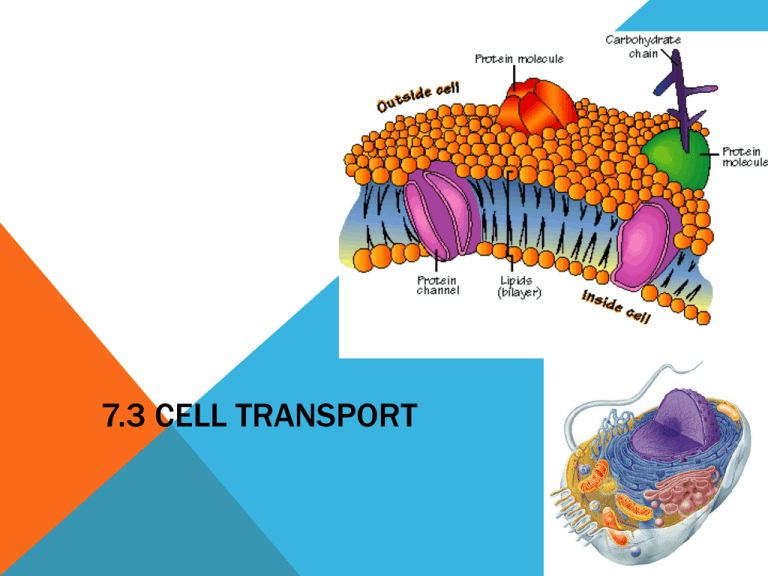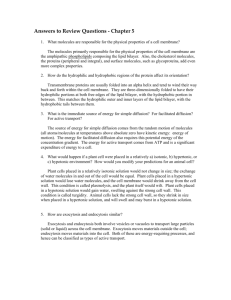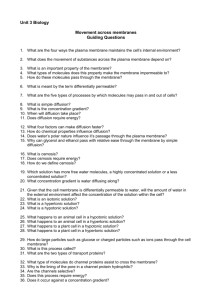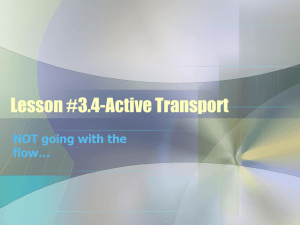Cell Transport Powerpoint
advertisement

7.3 CELL TRANSPORT 2006-2007 Function of the Cell Membrane: • Cell membrane separates the components of a cell from its environment—surrounds the cell • Regulates the flow of materials into and out of cell— selectively permeable • Cell membrane helps cells maintain homeostasis— stable internal balance Passive Transport A process that does not require energy to move molecules from a HIGH to LOW concentration Diffusion Osmosis Facilitated Diffusion • Diffusion is the movement of small particles across a selectively permeable membrane until equilibrium is reached. These particles move from an area of high concentration to an area of low concentration. outside of cell inside of cell • Osmosis is the diffusion of water through a selectively permeable membrane. Water diffuses across a membrane from an area of high concentration to an area of low concentration. Semi-permeable membrane is permeable to water, but not to sugar • Facilitated Diffusion is the movement of larger molecules like glucose through the cell membrane – larger molecules must be “helped” Proteins in the cell membrane form channels for large molecules to pass through outside of cell inside of cell Glucose molecules Hypertonic Solutions: contain a high concentration of solute relative to another solution (e.g. the cell's cytoplasm). When a cell is placed in a hypertonic solution, the water diffuses out of the cell, causing the cell to shrivel. Hypotonic Solutions: contain a low concentration of solute relative to another solution (e.g. the cell's cytoplasm). When a cell is placed in a hypotonic solution, the water diffuses into the cell, causing the cell to swell and possibly explode. Isotonic Solutions: contain the same concentration of solute as another solution (e.g. the cell's cytoplasm). When a cell is placed in an isotonic solution, the water diffuses into and out of the cell at the same rate. The fluid that surrounds the body cells is isotonic. Active Transport Active transport is the movement of molecules from LOW to HIGH concentration. Energy is required as molecules must be pumped against the concentration gradient. Proteins that work as pumps are called protein pumps. Ex: Body cells must pump carbon dioxide out into the surrounding blood vessels to be carried to the lungs for exhale. Blood vessels are high in carbon dioxide compared to the cells, so energy is required to move the carbon dioxide across the cell membrane from LOW to HIGH concentration. outside of cell inside of cell Carbon Dioxide molecules High Low • Endocytosis and Exocytosis is the mechanism by which very large molecules (such as food and wastes) get into and out of the cell Food is moved into the cell by Endocytosis Wastes are moved out of the cell by Exocytosis Ex: White Blood Cells, which are part of the immune system, surround and engulf bacteria by endocytosis WHAT IS THE DIFFERENCE BETWEEN PASSIVE AND ACTIVE TRANSPORT? Passive requires no energy and moves from high to low Active requires energy and moves from low to high. IN A HYPOTONIC SOLUTION… A. Cell shrivels up B. Cell swells up C. Remains the same IN A HYPERTONIC SOLUTION… A. Cell shrivels up B. Cell swells up C. Remains the same FOOD IS MOVED OUT OF THE CELL BY THE PROCESS OF A. Phagocytosis B. Exocytosis C. Endocytosis











